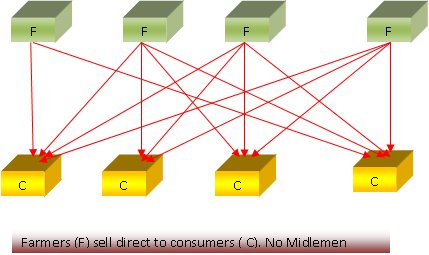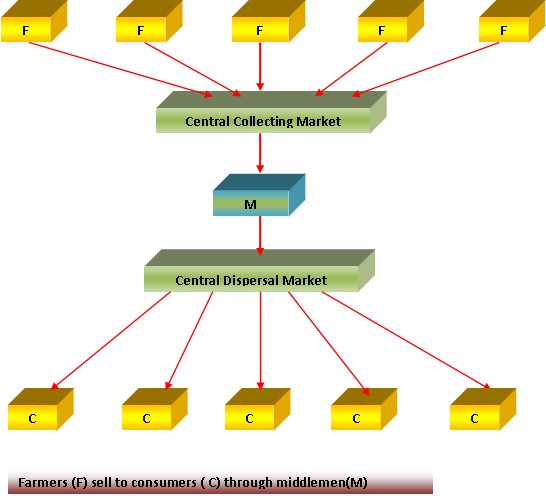CAEE 5131 - Agricultural Marketing and Price Analysis
Use of Institutional Approach
The recognition of various kinds of marketing organizations and the way in which they organize themselves furnishes another tool in analyzing marketing problems. Very often the ‘why’ of certain marketing practices must be answered in terms of the characteristics of who performed them. Such analysis has the advantage of preventing the personal aspects of marketing from being ignored.
Attitudes towards change or improvement must often be examined in the light of characteristics of the various marketing institutions. One of the greatest hazards of market improvement comes from institutions with large vested interests in the status quo. Marketing institutions give voice to the marketing machinery. From them develop ‘pressure’ and ‘educational’ groups attempting to mould public opinion. One of the cardinal rules to be followed in the analysis of many marketing controversy is first to ascertain which groups are vocal in the controversy and what they might stand to gain or lose.
The institutional approach can be helpful in understanding why there are specialized middlemen in the agricultural industry. It is possible to imagine an agricultural system without middlemen. Farmers can and at times do, perform middlemen activities as storage, transportation, selling, and even processing. By the same token, consumers can assume marketing middlemen functions. For example a farm roadside market eliminates the marketing middlemen by transferring his activities to farmers and consumers. Why, then, are there so many middlemen if there are no practical reasons why farmers and consumers could not replace them? The rationale for the existence of middlemen is that these specialized firms often can perform the marketing functions more efficiently than either farmers or consumers.
The rise of middlemen specializing in such activities as storage, transportation, processing, retailing and so forth is an example of division of labor and specialization. The middleman frees farmers for specializing in agricultural production and frees consumers for nonfarm career specialization. Normally there are gains from such specialization, and division of labor has become the hallmark of industrialized societies. Roadside farm markets, in contrast, may divert farmers’ time from agricultural production and require the consumer to perform the transportation and processing functions. These gains from specialization mean that many of the marketing functions are marked by economies of scale. That is, the average cost of performing the marketing functions falls as the volume of products handled rises. For example, the freight rate for a full car lot of grain is normally lower per bushel than for a less than car lot shipment. Typically, the average cost of processing and packing declines with increasing plant volume. These marketing scale economies encourage the growth of specialized middlemen. Middlemen also reduce market search and transactions costs. Markets are not costless. There are expenses associated with finding buyers and sellers and negotiating exchanges between them. By specializing in these functions middlemen relieve farmers and consumers of the considerable costs they would otherwise incur for search and transactions activity.
Attitudes towards change or improvement must often be examined in the light of characteristics of the various marketing institutions. One of the greatest hazards of market improvement comes from institutions with large vested interests in the status quo. Marketing institutions give voice to the marketing machinery. From them develop ‘pressure’ and ‘educational’ groups attempting to mould public opinion. One of the cardinal rules to be followed in the analysis of many marketing controversy is first to ascertain which groups are vocal in the controversy and what they might stand to gain or lose.
The institutional approach can be helpful in understanding why there are specialized middlemen in the agricultural industry. It is possible to imagine an agricultural system without middlemen. Farmers can and at times do, perform middlemen activities as storage, transportation, selling, and even processing. By the same token, consumers can assume marketing middlemen functions. For example a farm roadside market eliminates the marketing middlemen by transferring his activities to farmers and consumers. Why, then, are there so many middlemen if there are no practical reasons why farmers and consumers could not replace them? The rationale for the existence of middlemen is that these specialized firms often can perform the marketing functions more efficiently than either farmers or consumers.
The rise of middlemen specializing in such activities as storage, transportation, processing, retailing and so forth is an example of division of labor and specialization. The middleman frees farmers for specializing in agricultural production and frees consumers for nonfarm career specialization. Normally there are gains from such specialization, and division of labor has become the hallmark of industrialized societies. Roadside farm markets, in contrast, may divert farmers’ time from agricultural production and require the consumer to perform the transportation and processing functions. These gains from specialization mean that many of the marketing functions are marked by economies of scale. That is, the average cost of performing the marketing functions falls as the volume of products handled rises. For example, the freight rate for a full car lot of grain is normally lower per bushel than for a less than car lot shipment. Typically, the average cost of processing and packing declines with increasing plant volume. These marketing scale economies encourage the growth of specialized middlemen. Middlemen also reduce market search and transactions costs. Markets are not costless. There are expenses associated with finding buyers and sellers and negotiating exchanges between them. By specializing in these functions middlemen relieve farmers and consumers of the considerable costs they would otherwise incur for search and transactions activity.

Non specialised middlemen

Specialised Middlemen
Without middlemen, farmers and consumers would forfeit these economic gains from specialization and scale economies. This is illustrated in fig. 5. In fig. 5 each farmer sells directly to each consumer; all of the marketing functions are performed on small lots of product by either farmers or consumers; and farmers and consumers bear the full cost of finding and consummating desirable exchanges. This represents the farm roadside market situation. In fig. 6 specialized middlemen perform the marketing functions, allowing farmers and consumers to specialize in other activities and sparing them search and transaction expenses. Central markets facilitate middlemen specialization and scale economies by performing sorting and assorting activities.
Which is the better system? The general rule is that middlemen will perform the marketing functions when their costs for these functions are lower than those of farmers and consumers. The relevant comparison is the middlemen’s cost versus farmer or consumer costs for performing marketing functions, not middlemen’s cost versus no costs. Judging by the number and variety of middlemen, the condition appears to be frequently met in the agricultural industry. But this is not to say that all middlemen are efficient or necessary, or that farmers and consumers should never perform their own marketing functions. There are undoubtedly situations where the farmer and consumer should play the middlemen roles.
Figure (1) also illustrates that the need for middlemen tends to make the marketing system hourglass shaped. There are many more farmers and consumers than middlemen, and middlemen will normally be larger in size than the farmers and the consumers with whom they deal. This could provide food middlemen with advantageous bargaining position in the food system, and this may work to the disadvantage of farmers and consumers.
Despite their value, public distrust of middlemen continues. Throughout the world, middlemen are often scorned, sometimes outlawed, and usually merely tolerated. But because marketing is an activity practiced in some form in every country, those who take the time to understand it better usually come away with, if not a fondness for middlemen, at least a greater appreciation of their role in the economy.
Which is the better system? The general rule is that middlemen will perform the marketing functions when their costs for these functions are lower than those of farmers and consumers. The relevant comparison is the middlemen’s cost versus farmer or consumer costs for performing marketing functions, not middlemen’s cost versus no costs. Judging by the number and variety of middlemen, the condition appears to be frequently met in the agricultural industry. But this is not to say that all middlemen are efficient or necessary, or that farmers and consumers should never perform their own marketing functions. There are undoubtedly situations where the farmer and consumer should play the middlemen roles.
Figure (1) also illustrates that the need for middlemen tends to make the marketing system hourglass shaped. There are many more farmers and consumers than middlemen, and middlemen will normally be larger in size than the farmers and the consumers with whom they deal. This could provide food middlemen with advantageous bargaining position in the food system, and this may work to the disadvantage of farmers and consumers.
Despite their value, public distrust of middlemen continues. Throughout the world, middlemen are often scorned, sometimes outlawed, and usually merely tolerated. But because marketing is an activity practiced in some form in every country, those who take the time to understand it better usually come away with, if not a fondness for middlemen, at least a greater appreciation of their role in the economy.
Licensed under the Creative Commons Attribution Share Alike 3.0 License
This module was developed by Moi University, Department of Economics and Agricultural Resource Management with support from OER Africa and Bill & Mellinda Gates Foundation